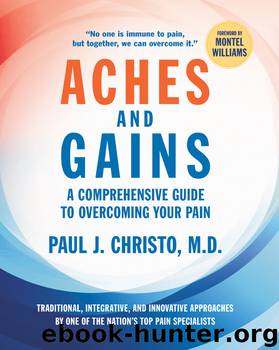Aches and Gains by Paul Christo

Author:Paul Christo
Language: eng
Format: epub
Publisher: Bull Publishing Company
Published: 2017-11-06T05:00:00+00:00
Medical Marijuana: Uses and Controversy
One of the oldest documented medicines in history, marijuana has many therapeutic uses. It has been used by people over the ages to:
◆manage pain, including the pain of childbirth
◆relieve muscle spasms and the spasticity of multiple sclerosis
◆reduce nausea
◆ease irritable bowel syndrome
◆stimulate the appetite
◆control glaucoma
Unfortunately, marijuana is also the most commonly used illegal substance in the United States and the world. Because of this, its medicinal use is controversial, both in the eyes of the general public and in the medical community. Some believe that marijuana has no medicinal properties that cannot be obtained just as effectively with standard pharmacological therapies. Others believe that restricting or banning marijuana’s use condemns countless individuals to needless and inhumane suffering. More recent studies highlight that medical marijuana does indeed have moderately good analgesic and antispasmodic effects and may help with sleep. Medical marijuana is already legal in several U.S. states and it may soon become a more common treatment option if it is ultimately approved by the FDA.
Cannabis is a flowering plant and a species of that plant, Cannabis sativa, contains chemical compounds called cannabinoids used for medical and recreational purposes. Cannabinoids are derived from plants (nabiximols), synthesized by pharmaceutical companies (dronabinol, nabilone), or produced inside the body (endocannabinoids). Pharmaceutical cannabinoids are cannabinoid-based medicines such as dronabinol (Marinol), nabilone (Cesamet), and nabiximol (Sativex). The popular term “medical marijuana” refers to using marijuana or cannabinoids as a medical treatment for diseases or alleviating symptoms from diseases. As a patient, this may mean receiving a medical marijuana certificate or recommendation in a state where it is legal to use. The specifics beyond its general approval for medical use are lacking—such as whether it should be smoked, vaporized, taken orally, in what dose and how often—because that would resemble a prescription, which doctors can’t write.
Various forms of marijuana can be smoked, inhaled as a vapor, taken orally, absorbed topically, or given intravenously. There are differences in how the drugs act on the body (oral versus inhaled), contents of the active ingredients (tetrahydrocannabinol [THC] versus cannabidiol), and the source of the drug (plant-based versus synthetic). Dispensaries are not currently subject to federal government standardization, so the potency of the marijuana now being sold legally in certain states can vary greatly.
As a result of its historically limited legal use in medicine, very few studies exist examining appropriate dosing and levels of potency, or comparing the effectiveness of the form (oral, inhaled, or smoked, for example) in which marijuana is taken. Thus, patients have had to experiment to determine which methods and levels of treatment work best.
Patients with multiple sclerosis (MS), spinal cord injury, pain from HIV, fibromyalgia, and arthritis have all reported relief from using medical marijuana. The strongest scientific evidence for pain relief exists for cancer pain, but neuropathic pain from MS, HIV, and trauma also shows positive outcomes. Some studies indicate that medical marijuana can lessen chronic pain by 30% or more.
Download
This site does not store any files on its server. We only index and link to content provided by other sites. Please contact the content providers to delete copyright contents if any and email us, we'll remove relevant links or contents immediately.
Men In Love by Nancy Friday(4972)
Everything Happens for a Reason by Kate Bowler(4481)
The Immortal Life of Henrietta Lacks by Rebecca Skloot(4264)
Why We Sleep by Matthew Walker(4193)
The Sports Rules Book by Human Kinetics(4081)
Not a Diet Book by James Smith(3156)
The Emperor of All Maladies: A Biography of Cancer by Siddhartha Mukherjee(2935)
Sapiens and Homo Deus by Yuval Noah Harari(2855)
Day by Elie Wiesel(2599)
Angels in America by Tony Kushner(2395)
Endless Forms Most Beautiful by Sean B. Carroll(2353)
A Burst of Light by Audre Lorde(2350)
Hashimoto's Protocol by Izabella Wentz PharmD(2206)
Dirty Genes by Ben Lynch(2164)
Reservoir 13 by Jon McGregor(2149)
And the Band Played On by Randy Shilts(2020)
Wonder by R J Palacio(1993)
The Immune System Recovery Plan by Susan Blum(1971)
Stretching to Stay Young by Jessica Matthews(1948)
